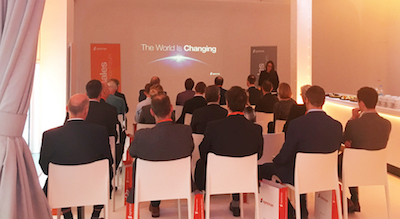 Revenues from original automotive product sales have been shrinking for some time as customers keep assets longer but companies are embracing the latest technology to maintain a good aftersales service for the long-term financial viability of their businesses.
Revenues from original automotive product sales have been shrinking for some time as customers keep assets longer but companies are embracing the latest technology to maintain a good aftersales service for the long-term financial viability of their businesses.
Attendees at last week’s Aftersales Excellence Forum in London, UK, hosted by cloud-based aftermarket services provider Syncron, learned more about the challenges facing the market and what was being done to improve dealer service levels for revenue growth.
“There is a correlation between having a really good aftermarket service and growing your business,” said Erik Kjellström, Syncron’s pre-sales manager. “Having a good aftermarket service creates a lot of loyalty with customers.”
However, to have a really good aftermarket service it is now essential to ensure maximum ‘product uptime’ – the measure of when a car or part is working and available – and this needs to be done through more efficient and proactive control of the aftermarket with the latest Industry 4.0 technology.
While automotive aftermarket inventory managers face particular challenges compared to their manufacturing counterparts – not least placating a more demanding and technically astute millennial customer base – having the right technology in place to quickly, and even predictively, replace parts translates into customer loyalty and longer-term revenue.
Margin growthThe automotive aftermarket business has always had greater margins than vehicle sales but now those margins are increasing across a number of sectors, according to figures from research firm Bain & Company cited at last week’s event.
Gill Devine, vice-president of sales for the EMEA region at Syncron, said the service parts sector now accounted for around 27% of overall revenue, while gross margins were almost 40%, according to the research. The Bain study also showed that manufacturing companies were growing their service business by an average of 9% against a general figure of 5%, a difference set to grow in the coming years.

“These numbers are impressive given the fact that the margin-rich aftersales business is often sub-optimised when it comes to spending on IT systems,” Devine pointed out.
The fact that spending on aftersales services is low compared to other parts of the business comes as a surprise when one compares the overall contribution to profit that the aftersales part of the business makes.
Referring to one of Syncron’s long-term customers, Kjellström said the service business at industrial equipment maker Atlas Copco, which accounts for between 10-15% of business revenue, now represented 50% of total profit at the company.
According to a Gartner study quoted by Adrian Botham, director of Servispart Consulting, which specialises in the aftermarket, while aftermarket activity accounts for something like 24% of revenue, it is worth between 40% and 80% of total profit in some businesses. Value-added services in the aftermarket are worth up to 30 times the return from sales of original equipment, said Botham.
However, at the moment, the typical manufacturer is only capturing 25% of their customers’ total service spend, according to Botham. He said that for every pound a customer spent with one particular company, they were spending three times as much somewhere else – either with a third-party logistics provider (3PL) or a direct competitor.
“Another way of looking at it is that if you make a product and you are an average manufacturer, you could quadruple the size of your aftersales business right now without having to find any more customers,” said Botham.
Customer centricityCapturing more of a customer’s total service spend, however, means becoming more customer-centric. Securing brand loyalty is an ongoing challenge and a more sophisticated level of customer service is central to it.
That is a bigger hurdle than it seems. Referring to another well-known Bain and Company study, Botham said that while 80% of companies believed they were giving superior customer service, only 8% of their customers agreed. What manufacturers are now discovering is that their customers’ expectations for aftersales services are increasing and 78% of manufacturers in a UPS survey conducted by business consultant IDC said that was the case.
“Many manufacturers are embarking on transformational journeys from ‘react and fix it’ to an environment where they look to maximise uptime,” said Devine.
She said that was driven by customer expectations and companies were trying to deliver maximum uptime in two main ways: the first was by servicing products faster and quickly responding to breakdowns by optimising the services they offered; the second was by getting into predictive maintenance, enabled by Industry 4.0 and the Internet of Things (IoT), something Devine said Syncron offered through its range of customer optimisation tools. Devine pointed in particular to Syncron Uptime, which takes real-time information from digitally linked parts through the IoT to proactively replace service parts before the equipment fails.
“A customer is happy when their equipment works,” said Kjellström. “Uptime starts with a great product and is backed up by the proactive avoidance of downtime.”
 Erik Kjellström, pre-sales manager, Syncron
Erik Kjellström, pre-sales manager, SyncronAn uncertain environmentThe question to ponder is why every company with a good product does not succeed in creating a good customer experience. That, according to Kjellström, is often down to the different methodologies applied in the manufacturing and aftermarket sectors. He said that while manufacturing was based on ensuring high throughput, limiting waste and providing precisely the material required at the last possible minute, the aftermarket was about maintaining a high availability of parts in low volumes. Whereas manufacturing was driven by consistent demand and high volumes, or large customer orders, based on a sales forecast, demand in the aftermarket was typically driven by equipment failure or service level agreements, he stressed.
“In the aftermarket you are working in a more uncertain environment, so you need to keep the stock just in case,” said Kjellström –something crucial given the Aberdeen Group study that suggested 52% of service attempts fail first time around because of a lack of serviceable parts.
However, there is a fundamental problem limiting the full potential of aftermarket margin growth, which is that the tools many organisations use for aftermarket material management are inadequate.
“That includes the fact that an ERP [enterprise resource planning] system is designed for manufacturing and it really doesn’t fit the requirements of the aftermarket,” said Kjellström. “Service organisations often don’t have the tools they need.”
Maintaining high service levels while at the same time handling hundreds of thousands of parts at locations all over the world requires a careful strategy that balances inventory costs and service level requirements. Doing this with a smaller budget and relatively small team is difficult, he said.
“Each spare parts manager needs to look at solving the puzzle for thousands of parts every day and typically the team that an OEM has to manage that is small,” Kjellström added. “It is a significant piece of the business that the small team has in their hands [and] not proportionate to the revenue their department generates.”
Nevertheless, it can be done with the right technology. Kjellström used the forum to outline some case studies for customers, including Deutsche Bahn and Volvo CE, where services were improved and reductions in expensive expedited part shipments made by optimising networks of companies involved in the aftermarket. Given the expense that can be incurred if a piece of agricultural or mining equipment is out of service even for an hour, the existence of ‘smart’ parts that are linked to a software system that can issue a replacement based on predictive analytics before the part in question fails is important in gaining customer trust. Syncron has a number of customers in the commercial and agricultural sector.
Kjellström also pointed to the advantages of Volvo Cars CarePlus system which is based on telematics data sharing (subject to agreement with the customer) and can provide 100% uptime for a passenger vehicle by monitoring part performance and sending signals to the owner when an upgrade or replacement is necessary.
Embracing innovation like this is no longer a luxury for aftersales services, said Gill Devine, because customers today are unforgiving.
“Those who fail to innovate and [who] resist change will fail to deliver on their expectations,” she warned.





































